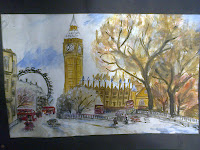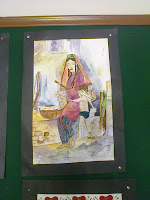Cooking is one of the best modes of
expression which, like many Pakistani ladies, is also used by my sister. Like
my sister, we all have our own methods of expression. While working at “Ida
Rieu: School and College for Blind and Deaf,” I realized that visually impaired
children are comfortable using music to express themselves, while hearing
impaired children prefer painting.
Visually impaired children are fond
of singing. When I was helping them with their public speaking skills, asking
them to sing a song was the best way to make them take the floor and face the
audience. They are always ready to form a choir and sing for you. The following
praise does wonders for them. Not all teachers, however, are supportive which
can have a negative impact on their personalities. Both, teachers and parents
are responsible as their words are of tremendous impact. A normal person can
tell by seeing into the eyes of the audience that magic has been created, but
for a visually impaired, the only evidence is the audience’s generous applause.
Speech Craft: The New Stage : http://professionaltoastmaster.blogspot.com/2011/11/speech-craft-new-stage.html
Hearing impaired children, on the
other hand, are comfortable expressing themselves through their artwork. Paint
brushes and colours are not only cheap but also allow them to be creative on a
piece of plain paper. Their expression can stretch from a simplest idea to the
most complex concept. However, this does not mean that they are imprisoned
within these limits: The visually impaired can draw and the hearing impaired
can sing, too.
 |
|
Artwork by the hearing impaired children at Ida Rieu
|
 |
|
Artwork by the hearing impaired children at Ida Rieu
|
 |
|
Artwork by the hearing impaired children at Ida Rieu
|
 |
|
Artwork by the hearing impaired children at Ida Rieu
|
 |
|
Artwork by the hearing impaired children at Ida Rieu
|
 |
|
Artwork by the hearing impaired children at Ida Rieu
|
 |
|
Artwork by the hearing impaired children at Ida Rieu
|
 |
|
Artwork by the hearing impaired children at Ida Rieu
|
In China’s southern Guangxi
province, Zeng Bailiang has spent almost 40 years teaching art to the visually
impaired, most of whom are orphans. There are also other institutions in the
world which teach art to the visually impaired, but Zeng’s techniques are quite
different as he uses brush strokes on a special paper, letting the students
feel the wet and dry areas of the paper. Instead of viewing art as an
“aesthetic form,” he views it as an “emotive form.”
- China's blind painters: http://www.aljazeera.com/video/asia-pacific/2011/01/2011117184521277375.html
- In China, Blind Students Learn Art and Self-Esteem: http://www.care2.com/causes/in-china-blind-students-learn-art-and-self-esteem.html
- Coloring the darkness: http://usa.chinadaily.com.cn/life/2011-02/16/content_12023942.htm
In the eleventh episode of the first
season of the American T.V. series, “Glee,” a new perspective was shared with
the world with respect to singing by the hearing impaired. The name of the
episode was “Hairography” and a choir of deaf children was shown performing over
John Lennon's "Imagine." The hearing impaired child with developed
speech was singing by using both, his speech and sign language, while the rest
were singing only through sign language.
"Glee" Hairography (TV
episode 2009) - IMDb: http://www.imdb.com/title/tt1442933/plotsummary?ref_=tt_ov_pl
Christine Ha, aged 34, became the
first visually impaired contestant in the third season of the “US MasterChief”
in 2012. She not only won the contest but also amazed the world with her
culinary skills. She gradually lost her vision but proved to the world that it
wasn’t a hurdle in her expression and creative skills. She is now looked up at
as an inspiration by many such children in Pakistan.
This Blind Cook Just Took Home $250K After Winning 'MasterChef': http://www.businessinsider.com/blind-contestant-wins-masterchef-2012-9
In the edition of June, 2012 of
Toastmasters Magazine, an article, “Tara Miller: LACKING SIGHT, BUT NOT VISION”
by Julie Bawden-Davis was published. It was about a visually impaired
photographer who used her senses while taking the photo. However, she has to
enlarge that particular photo by 400 percent on the computer screen afterwards.
In 2012, she won several awards for her picture, “Fortuitous Twilight.”
Tara Miller: LACKING SIGHT, BUT NOT
VISION: http://magazines.toastmasters.org/display_article.php?id=1058142&id_issue=110955
Singing and painting are not the only
creative ways which hearing and visually impaired children use to communicate.
When it comes to non-verbal communication, body language is considered to be
one of the best ways to express oneself, especially during the interpersonal
communication and public speaking. Most of the hearing impaired children
exercise and appear confident because they have command, not only on their body
language, but also over their motor skills. Their face is full of countless
expressions and emotions. On the other hand, slouching of shoulders by the
visually impaired children makes them appear less confident. Children who are
partially sighted copy others’ body language and improve. It is also very easy
to explain the proper use of the body language to those children who were never
visually impaired by birth but gradually lost their sight.
 |
|
Comfortable using body language because he became visually
impaired later in life
|
 |
|
Comfortable using body language because he is partially
sighted
|
 |
|
Visually impaired child will often slouch.
|
Visually impaired children can,
however, win your hearts through their command over speech. They are well
equipped in properly formulating beautiful words and phrases while carefully
judging the circumstances and the environment around them. They are able to
present themselves more sophisticatedly in this manner. This also reveals
another aspect of their personality which is their emotional fragility. They
can easily be hurt, and therefore, anyone who is working with them, needs to
take extra precaution.
To perceive world through one’s
senses is a gift which almost everyone enjoys, but to be able to express is
not. Not everyone is blessed with this endowment. Even though these children
are not fully equipped with all the senses, they are still able to put to good
use those available to them.










